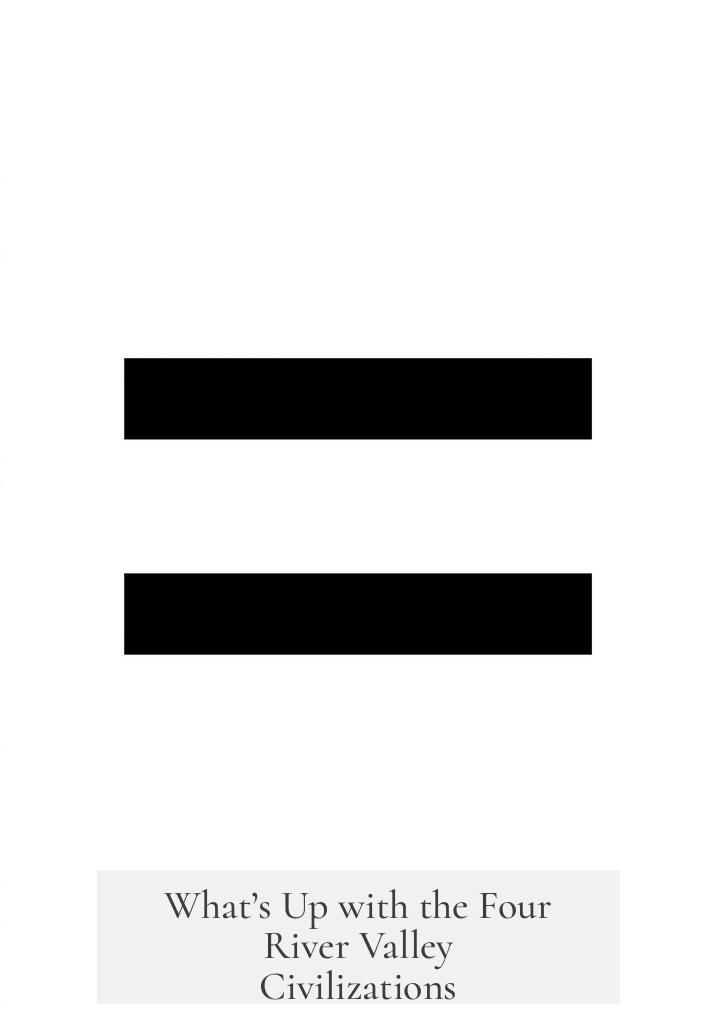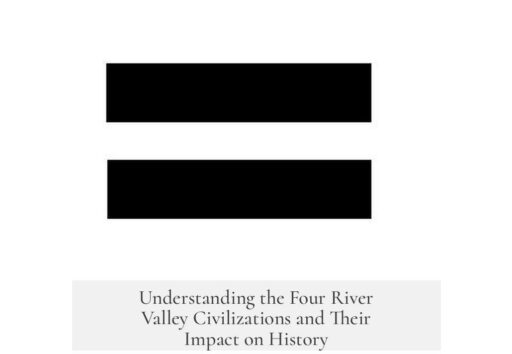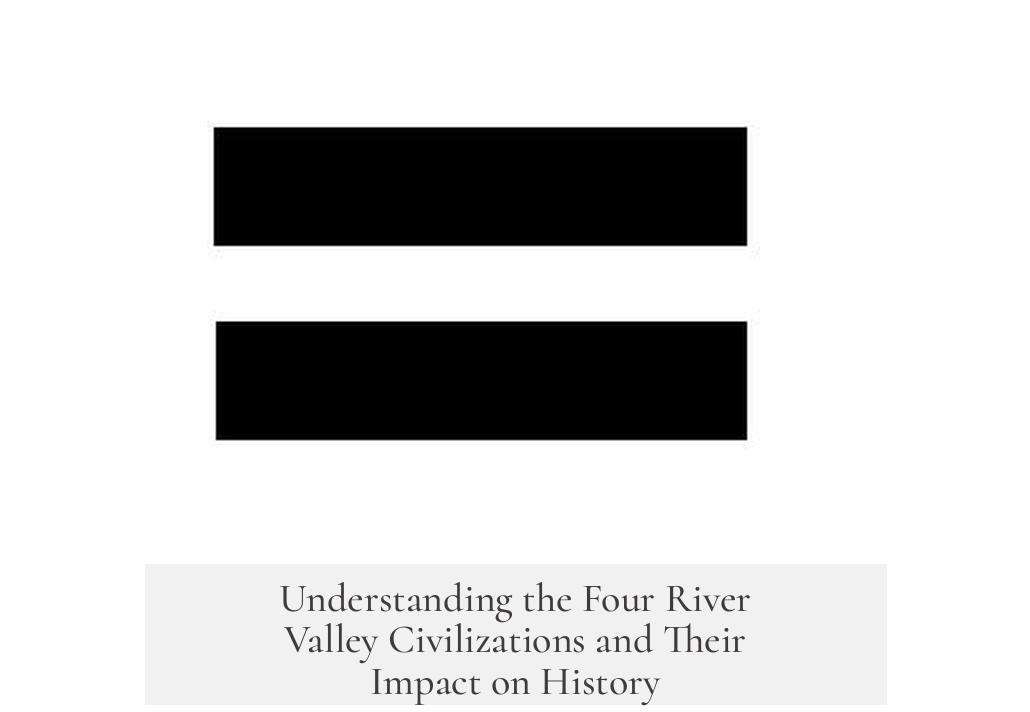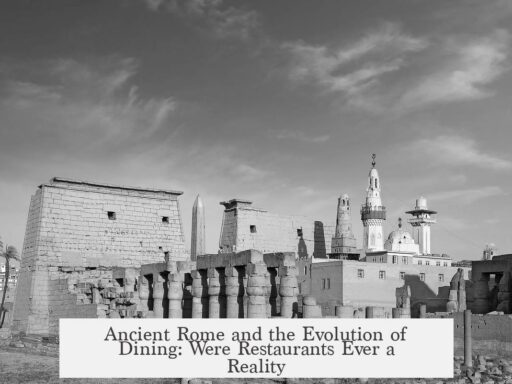The four river valley civilizations are the earliest known complex societies, all situated along major rivers. These are Mesopotamia (between the Tigris and Euphrates), Ancient Egypt (Nile), the Indus Valley (Indus River), and Ancient China (Yellow River). Their positioning on rivers provided vital fresh water, enabling agricultural surplus, urban growth, and technological advancements crucial for early civilization development.
These civilizations mark some of the earliest examples of societies with complex social structures, advanced technologies, and organized cities. They developed independently and displayed unique innovations suited to their environments. The rivers supplied irrigation for farming, supporting dense populations. Such resources allowed populations to specialize beyond food production, leading to cultural, technological, and political complexity.
Though commonly grouped, this traditional focus on the four river valley civilizations excludes other significant early civilizations like the Meso-American Olmecs and the Andean Norte Chico culture. These American civilizations, despite less understood histories due to limited written records, also achieved advanced social and architectural feats. However, the four Old World river civilizations remain prominent because of their early independent writing systems and well-documented histories.
One key trait distinguishing these civilizations is their development of writing systems, an indicator often used to separate ‘history’ from ‘prehistory.’ Mesopotamia’s cuneiform and Egypt’s hieroglyphs are early examples, as are the undeciphered scripts of the Indus Valley and Ancient China. The Andean civilizations developed the quipu, a knotted-string record system capable of recording numerical data but likely not full language. This variation highlights different approaches to record-keeping and communication across early cultures.
Understanding the precise origins and relationships between these writing systems remains complex. Archaeologists debate whether they appeared independently or through cultural contact. Evidence shows trade and interaction, especially between Mesopotamia, Egypt, and the Indus Valley. Yet, writing forms and technologies were distinct, suggesting independent innovation with some cross-cultural influences.
Beyond these four river civilizations, many other early societies reached impressive levels of advancement and complexity. For example, Anatolia’s Çatalhöyük had large settlements, the Cucuteni-Tripolye culture in Eastern Europe showed proto-writing and extensive trade networks, and the Bronze Age cultures in Central Asia and West Africa achieved notable social organization. These societies sometimes challenge the conventional definition of civilizations centered solely on writing and cities.
Scholars caution against narrow definitions that label only a few cultures as true ‘civilizations.’ Many prehistoric cultures achieved remarkable technological and social milestones gradually, rather than through sudden leaps. This broader view discourages misrepresenting earlier humans as primitive or simplistic. Instead, it acknowledges the long, complex process of cultural development worldwide.
In summary, the four river valley civilizations highlight key early examples of human societal complexity focused around major waterways. Their ability to harness river resources led to breakthroughs in agriculture, urban living, social hierarchy, and writing. However, it is important to recognize other ancient advanced cultures globally, whose contributions deserve equal appreciation. The notion of civilization must remain flexible and inclusive to reflect human diversity over time.
| Civilization | River(s) | Key Innovations | Writing System |
|---|---|---|---|
| Mesopotamia (Sumer) | Tigris & Euphrates | Irrigation, city-states, cuneiform | Cuneiform script |
| Ancient Egypt | Nile | Pyramids, hieroglyphics, centralized monarchy | Hieroglyphs |
| Indus Valley | Indus River | Urban planning, drainage systems, undeciphered script | Indus script (undeciphered) |
| Ancient China | Yellow River | Bronze casting, oracle bones, early writing | Oracle bone script |
Key points on the four river valley civilizations:
- All emerged along major rivers providing water essential for agriculture and urban life.
- Each featured distinct technologies and social structures, often independently developed.
- They represent some of humanity’s first examples of written language, though some scripts remain undeciphered.
- Interaction and trade occurred between some river civilizations, but their core developments were largely independent.
- Other early advanced cultures existed worldwide, challenging a narrow definition of civilization.
- Understanding their complexity helps avoid misconceptions that early humans were simplistic before these civilizations.
What’s Up with the Four River Valley Civilizations?

When someone asks, “What’s up with the four river valley civilizations?” they are really asking about the ancient cultures that planted the seeds of urban life beside great rivers. These cultures—Mesopotamia, Egypt, the Indus Valley, and ancient China—are often called the cradles of civilization for a reason. Let’s unpack what’s fascinating about them without getting lost in jargon or dry textbook stuff.
First off, why rivers? Imagine trying to build a city in the desert without a reliable water source—it’s a tough gig. These civilizations emerged where rivers provided fresh water, fertile soil through annual floods, and a transportation route that fueled commerce and cultural exchange. The mighty Tigris and Euphrates, the Nile, the Indus, and the Yellow River didn’t just nourish crops; they nourished humans’ first experiments in large-scale societies.
These cultures weren’t just about farming. They rocked technological breakthroughs, built sprawling cities, and crafted social structures that amazed even by today’s standards. Big temples, aqueducts, administrative buildings, and for the first time, writing systems also popped up. Writing was so crucial, historians once used it to mark the split between “history” and “pre-history.”
The Four Cradles and Their Treats
- Mesopotamia (Sumer) – The land of the first cities and the earliest known writing system, cuneiform. It’s where folks first jotted down not just shopping lists, but epic stories like the Epic of Gilgamesh.
- Egypt – The Nile River Kingdom. Imagine building pyramids and temples for gods and pharaohs along a life-giving river. Their hieroglyphs and monumental architecture remain iconic.
- Indus Valley Civilization – Located in present-day Pakistan and northwest India, these folks engineered impressive urban planning with grid cities and advanced drainage systems. Their script remains undeciphered, adding a dash of mystery.
- Ancient China – The Yellow River civilization brought innovations from silk to bronze tools and unique characters for writing. Their culture profoundly shaped future dynasties.
But wait, you might be thinking: what about those other fascinating places like Meso-America and the Andes? They often get excluded from the “four river valleys” discussion because their major cultures don’t fit the traditional “Old World” frame, and their histories are less documented. The Olmecs and Norte Chico cultures had unusual record-keeping systems and urban centers that challenge simplistic ideas about what a civilization looks like. For instance, while most early civilizations developed writing, the Andean culture crafted quipu, a sophisticated knotted-string record system that can’t fully capture language but still managed information efficiently.
More Than Just Four – The Bigger Picture
The traditional focus on these four river valley civilizations often masks the broader reality: history is messy. Many other cultures reached an advanced level, marking their own path toward urban life and technology.
- Ancient settlements like Çatalhöyük in Anatolia had large populations and complex societal roles.
- In Eastern Europe, the Cucuteni-Tripolye culture created massive settlements and impressive artistry well before many Old World civilizations arose.
- Central Asia’s BMAC culture, West Africa’s Nok people, and Southern Africa’s Great Zimbabwe show that advanced societal and technological development was happening globally.
So, why do we still talk mostly about the four river valley civilizations? It partly boils down to records and archaeological visibility. Writing survives better than oral traditions or perishable materials, and rivers tend to attract human settlements that persist longer and leave clearer traces.
Civilization—A Tricky Term
“Civilization” as a word is slippery. It isn’t universally defined, and many scholars now hesitate to use it without context. The traditional criteria include big cities, social hierarchy, centralized governments, technology, and writing systems.
Does that mean people who didn’t build stone pyramids or write with symbols were “primitive”? Not at all. This belief is a misconception that unfairly stereotypes whole cultures as less complex or intelligent. Human history was a gradual climb, not a sudden leap, with many cultures advancing at different paces and directions.
Interconnectedness Versus Isolation
Another point worth chewing over: How much did these civilizations know about one another? Mesopotamia, Egypt, and the Indus Valley traded goods. Sometimes the trade routes carried ideas, too—proto-writing in Egypt and Mesopotamia emerged independently, but could there have been some cross-pollination?
As for China, it largely developed in isolation in its early days, incubating unique writing and inventions. The mystery grows when we consider how some symbols in Meso-America’s script remain undeciphered, leaving us guessing about their communication methods.
Wrapping It Up—Why It Matters Today
Understanding the four river valley civilizations helps us appreciate the roots of modern society. Yet, it’s just the tip of the human story iceberg. Each one shows a different way humans solved age-old problems: how to feed populations, organize communities, create laws, and record ideas.
By broadening our view beyond just these four, we challenge old stereotypes and recognize the diverse ingenuity of humanity. When you think about it, this is a lot more exciting than some dusty old textbook made it sound.
So, next time you hear about “the four river valley civilizations,” remember: they’re critical players in a much bigger narrative. They remind us that rivers aren’t just bodies of water—they are the veins through which civilization’s lifeblood once coursed, and that history’s tapestry is vibrant, complex, and full of surprises.




